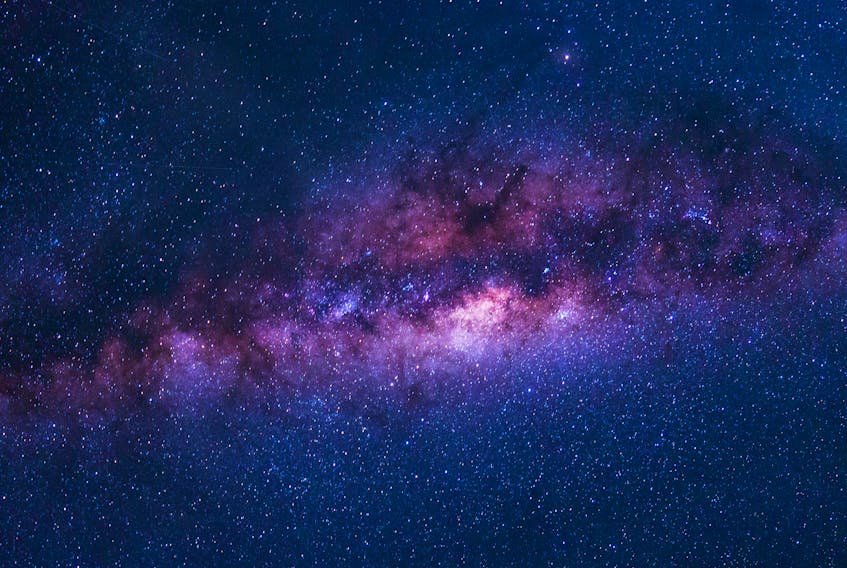The joy of my life, my granddaughter Scarlet, asked me the other day, "Poppy, how big is the universe?"
Her boundless curiosity never ceases to amaze me. I attempted to explain to her, as best I could to an eight-year-old who has never travelled further than Halifax, N.S., that the universe, as we currently understand it, is very large - so large, in fact, that we have to measure it, not in terms of kilometers, but, rather, in light-years. Even then, the numbers are extremely big.
I am not sure my explanation of exactly what a light-year is (how far light travels through space in the course of one year, or approximately 9.5 trillion kilometers), and, how when multiplied by how far (in light-years) we can see out into space, did much to answer her initial query, as the resulting silence and quizzical expression on her face told me she couldn't really grasp such distances (who can blame her?).
Her response just about summed up what, I imagine, most people would say: "Guess that really is pretty big, isn't it, Poppy?"
"Yes, my darling, it certainly is," I replied.
In the 1920s, the American astronomer, Edwin Hubble (after whom the Hubble Space Telescope is named) and his assistant, Milton Humason, proved that the galaxies they were studying and photographing were, in fact, moving outward as viewed from Earth, or receding, into deep space, and further, that the more distant the galaxy, the faster it was receding. This became known as Hubble's Law.
Hubble's discovery actually grew out of earlier work by Albert Einstein, who, in 1917, predicted that the universe was expanding, because space itself was expanding. Although, at the time, Einstein wasn't confident enough in his expanding universe theory to publish it, it later formed the basis for his famous General Theory of Relativity.
When I use the term "universe" here, I mean the observable universe, the farthest point that we can see out into space with our best astronomical telescope - the Hubble Space Telescope (HST). In 2016, the HST photographed what, to date, is the most distant object - the galaxy GN-z11. Taking the expansion of the universe into consideration, it is approximately 32 billion light-years, or approximately 3.04 sextillion (3.04 followed by 21 zeros) kilometers away; a truly mind-boggling distance.
However, astronomers theorize that the actual universe is much, much larger. Starting at the moment of the universe's theoretical creation (called the "Big Bang", though not an actual explosion), the accepted age of the universe is now thought to be approximately 13.8 billion years. As the universe continues to expand, the most distant point in space from which we will ultimately receive light back from distant galaxies (which are increasingly moving away from us), known as the "cosmic horizon", is estimated to be about 46 billion light-years away.
It is theorized that, due to the increasingly rapid rate of expansion of the universe as a whole, we will never see any light from objects beyond the cosmic horizon. However, when the James Webb telescope (a much larger and more sophisticated telescope than the HST) is launched on Oct. 31, 2021, the boundaries of the known universe will, undoubtedly, be extended.
Though the above distance figures are truly mind-blowing. and may make you feel incredibly small, it should, at the very least, underscore just how unique our life-bearing planet Earth is in the great infinite vastness of the cosmos and how wonderfully precious it is to have children and grandchildren who challenge you to think about it.
This week's sky
Mercury remains too close to the sun to be visible this coming week. Venus (magnitude -4.2) is visible, as it has been these past few weeks, in the pre-dawn sky. It rises around 2:45 a.m., reaching its highest point at 34 degrees above the eastern horizon, before fading from sight as dawn breaks around 6:15 a.m.
Mars (magnitude -1.8) is visible in the early morning sky, rising in the east around 10:30 p.m., and achieving its highest altitude (50 degrees) above the southern horizon by about 4:20 a.m., before becoming lost in the dawn twilight by 6:15 a.m.
Jupiter and Saturn remain early evening objects, both visible side-by-side (bright Jupiter to the right) above the southeast horizon by about 8:30 p.m. Jupiter (magnitude -2.58) disappears from view around 12:40 a.m., when it sinks below seven degrees above the southeast horizon, followed by Saturn (magnitude +0.31) around 1:30 a.m., when it sinks below 10 degrees above the southwest horizon.
When the full moon closest to the Autumnal Equinox (Sept. 22), occurs in October, as it does this year on Oct. 1, it is known as the "Harvest Moon". September's Full Moon (Sept. 2) is referred to as the "Corn Moon," the name given to it by Native American tribes, as this was when they usually harvested their corn crops.
Until next week, clear skies.
Events:
- Sept. 2 - Full (corn) moon
- Sept. 6 - Moon at apogee (farthest from Earth)
Glenn K. Roberts lives in Stratford, P.E.I., and has been an avid amateur astronomer since he was a small child. He welcomes comments from readers at [email protected].









